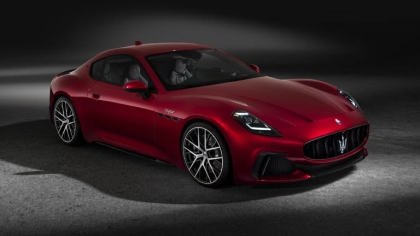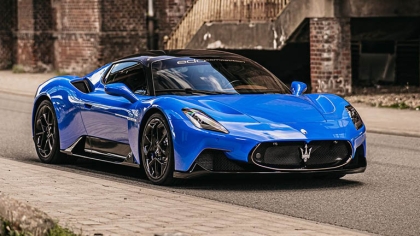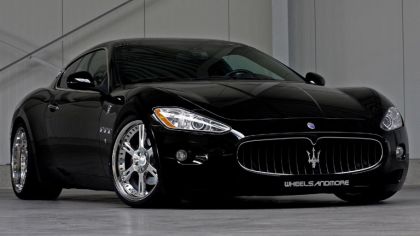When Maserati started work on the MC20 project, the halo car that marked the beginning of a new era for the House of the Trident, it had already decided to return to the track. After the launch of the MC20, the upshot was the Maserati GT2, which took the Modena-based manufacturer back to racing victory in the 2023 Fanatec GT2 European Series Championship. Even so, leaving so much power and beauty only on the track would have been a waste. Here then is the Maserati GT2 Stradale, another legitimate daughter of the MC20 - sister of the GT2 only type-approved to be driven between the kerbs - the state of the art of Maserati performance.
From the outset of the MC20's technical development, a racing evolution was envisaged for the car that formed part of the project, which then came to life in its natural expression - the GT2 and its road-going counterpart the GT2 Stradale, both developed in parallel by the same team that shares technological know-how and certain specific components.
The Maserati GT2 Stradale thus stems from an opportunity to offer a more performance-oriented product type, with growing popularity among super sports car customers. In addition, the Trident's rich history of success in racing has contributed significantly to strengthening the brand's image and authenticity in the high-performance car sector.
GT2 Stradale is a car rooted on the track and type-approved for use on the road, with the ability to combine the extreme, refined performance of the racing world with the option of driving it on the road. A road-legal track car that combines the best of the MC20 and GT2: top speed of 324 km/h - beating the previous track time set by the MC20 on the "Misto Alfa" track at Balocco by over 5 seconds; maximum output increased to 640 hp (471 kW) - 10 hp more than the MC20; acceleration from 0 to 100 km/h in just 2.8 seconds, making it the most agile rear-wheel drive (RWD) in its category.
GT2 Stradale pairs extraordinary performance on the track made possible by unprecedented handling, the main contribution to which has been the great work done by the engineers to increase the aerodynamic downforce - now a perfectly balanced 500 kg, with the refined task of reducing the weight (by 60 kg compared to the MC20 in its standard configuration). As well as performance, the car is also at home on any type of road, courtesy of the front lift (an on-demand option in various markets that raises the car by 35 mm at an angle of 3°), making it possible to travel along even the roughest routes. The 100-litre boot also makes it suitable for everyday use.
As seen in the MC20, the butterfly doors make it easier for the driver and passenger to get in. Stagy, but practical too.
GT2 Stradale is definitely a high-tech model that can provide extreme performance on the track, but it is also a welcoming car that can be used on an everyday basis, courtesy of the level of comfort and specifications such as ADAS. It can therefore even be driven in the city, with aids such as cameras and parking sensors, now essential for a certain category of cars.
Maserati has a long and glorious sporting history, begun by the Maserati Tipo 26 - the first to bear the Trident in a race - when it took first place in its class at the 1926 Targa Florio. Since then, it has effectively never stopped, with wins in Formula 1 and endurance, racking up victories, world titles and world records one after another. Maserati is a brand born to race and now, after taking over the greatest chapters of motorsport with the now-legendary MC12, it is back on the track with the GT2. Yet Maserati has also become a symbol of luxury on roads around the world. GT2 Stradale aims to become the link between the two worlds, bringing emotions and unique performance, without sacrificing the comfort to take on a challenging journey.
The GT2 Stradale already had an excellent starting point, but the Maserati team has managed to raise its performance even further, by increasing the power and significantly reducing the weight, to emphasise its dynamic qualities that translate into greater driving pleasure and ease.
Exterior
The Maserati GT2 Stradale is based on the same ultra-light carbon fibre chassis as the GT2 track car, already shared with the Maserati MC20 coupé and MC20 Cielo road models, to ensure maximum lightness, uncompromising torsional rigidity and extraordinary handling on the most challenging roads and on the track.
Each solution identified to transform the GT2 into a road car responds to a need. Nothing is included as an aesthetic enhancement alone. Everything is there for its own reason, to improve aerodynamics and therefore the car's performance.
Once again, the Maserati GT2 Stradale was created at the Maserati Centro Stile. The work of the men and women at the Centro Stile focused on attention to the design of all areas of the car, where changes have been made for the type approval of the GT2, maintaining an extraordinary level of performance without neglecting the sporty spirit successfully brought to the road by the Maserati MC20.
The front features a new design, maintaining the typical Maserati architecture and adapting to requirements in terms of cooling and aerodynamics; the forms are functional to the vehicle dynamics. The front 'mouth' (known in development as the "shark nose") has been broadened, ensuring greater air flow and introducing an aesthetic concept that will be seen again in future Maserati models.
Maserati designers have worked on the redesign of the front to maintain the assertiveness of the GT2, as well as the sporty spirit and functionality, with intakes to bring in fresh air for cooling purposes.
The front bonnet was also developed and previously introduced in the racing version (GT2); the GT2 Stradale takes it up in full, with adaptation for the specific aerodynamic requirements of load balancing and to expel hot air.
The number three and the revisited Trident are again a constant in the style of the Maserati GT2: there are three air vents in the bonnet, another three in the front wheel arches, three more near the rear window, and nine-spoke wheel rims, forming a Trident in threes.
The area around the front fender has been revamped with the introduction of air outtakes in the upper part of the fenders (from the GT2), to let out hot air to cool the brakes and reduce the pressure inside the wheel arches.
The air intakes in the rear fenders, on the other hand, have been completely redesigned and enlarged, producing a new carbon-fibre cupola to improve the flow of cold air (+16%), to supply the engine and cool the radiators.
The carbon-fibre spoiler has been revised compared to the MC20 design, increasing its surface area, and the wing with a boomerang design and built-in endplates has been added. The all-new rear wing, inspired by the GT2's, is connected to the car with pylons in the form of structural poles in solid aluminium. The fastening system offers three different adjustments with the same number of levels of aerodynamic downforce. To support the load, the bonnet area has been reinforced.
In the rear, the large extractor stands out, completely redesigned to facilitate the extraction of air from the underbody, to generate downforce as well as making the car more assertive. The exclusive design of the lower area was created based on input from aerodynamics, to push performance to the max; revisions have also been made from the racing version.
Seen from behind, the GT2 Stradale has even more grit from the large rear wheels being left visible, as an interruption in the bodywork.
Outstanding aerodynamic performance
Aerodynamic downforce is one of the pillars of the development of the Maserati GT2 Stradale, in the quest for improved handling. Driving pleasure is achieved with an increase in lateral performance on corners, by improving Cz downforce without compromising too much on Cx longitudinal efficiency.
The GT2 Stradale can generate 500 kg of aerodynamic downforce at 280 km/h with the 'high drag' rear wing setting (130 kg at the front and 370 kg at the rear) compared to the MC20's 145 kg at 280 km/h (35 kg at the front and 110 kg at the rear).
Work has also been done on the overall balance, thanks to the specific aerodynamic effect of the front bonnet, -based on the GT2 racing car's. The result is a car with even higher performance, increased dynamic capabilities, and greater agility and ease in sports driving conditions.
The higher aerodynamic downforce has very little effect on the top speed compared to the average among its competitors, courtesy of the great deal of engineering work done on the aerodynamic efficiency/performance.
The rear wing, revisited by introducing the boomerang design and maximising its load area as much as possible, without compromising its longitudinal efficiency (Cx), leaves the factory at a neutral setting, but can be adjusted to increase or decrease the load, a manual operation.
Many of the specifications are directly derived from the racing version of the GT2, especially the technical components that affect aerodynamic performance: at the front, the new carbon-fibre bumper design with a large splitter increases downforce, whereas dedicated air intakes improve brake cooling.
Also directly derived from the GT2, the carbon-fibre bonnet with aesthetic carbon-fibre flaps. It allows the air from the central radiator to be discharged onto the front bonnet, increasing the aerodynamic downforce at this point and balancing its generation by the rear wing: all specific actions taken to increase the driveability of the GT2 Stradale, even in extreme conditions.
The 20" single-nut forged wheels with a racing design, the size of which is based on the car's loads, is also taken from the GT2, providing a reduction of approximately 19 kg compared to the basic version in the current models. The oversized side air ducts have been extended to bring more fresh air to the engine and side radiators; the new rear diffuser with extreme geometries increases the air flow in the underbody and therefore the load.
In addition, in terms of aesthetic perception, a great deal of work has been done to make the car much more extreme: for the first time on a Maserati, a matte carbon fibre finish has been introduced, as an even more 'technical' treatment that brings it even closer to its racing sibling.
Various features for the interior and exterior of the GT2 Stradale are available in aesthetic carbon fibre.
The interior includes:
doorsills (optional)
steering wheel paddles (optional)
cluster cover (optional)
new central tunnel blade (upper part)
new central tunnel blade holder (spider) (optional)
monocoque seat
exposed carbon fibre monocoque on the floor
steering wheel inserts
Exterior features:
front bumper (optional)
rear diffuser (optional)
side skirts (optional)
racing aerodynamic flaps on the bonnet
racing bonnet(optional)
roof (optional)
air intakes on rear fenders (optional)
air outtakes on front fenders (optional)
rear adjustable wing
rear spoiler
Colours
The Maserati GT2 Stradale also has a dual aesthetic spirit, with the upper part in body colour and a technical lower section in carbon fibre painted matte black. The painted carbon fibre is also taken up in the roof, bonnet and large rear spoiler. All these components are also available in aesthetic carbon fibre as an optional extra.
The GT2 Stradale also conveys its sporty spirit in its colours and materials. Four colours are available, referring to four worlds frequently explored by Maserati: the essential, heritage, contemporary and location-based worlds.
Nero Essenza - an agile glossy colour, perfect for an assertive car
Blu Infinito - an iconic colour that can never be left out from a Maserati
Gloss Giallo Genio - with a blue mica reminiscent of Modena's colours
Matte Bianco Audace - a pure white with a blue mica
The calliper colours available for the GT2 Stradale are black, red, silver, yellow and oxidized blue. The wheel rims are matte black.
Digital Aurora Matte - a new entry in the Fuoriserie palette - was chosen as the launch colour of the car, as a blue with shades of red and a magenta mica. A technical yet simultaneously on-trend colour. A colour that will never go unnoticed.
The personalisations available as part of the Maserati Fuoriserie customisation programme also include additional colours:
Grigio Lamiera Matte - a matte colour reminiscent of the sheet metal seen in the earliest racing cars, revisited with a modern twist
Digital Mint Matte - a greenish-blue colour, with a very light red mica that recalls the legendary MC12 GT1 Vitaphone, yet simultaneously speaks of modernity
Nero Cometa Textured - with a rough hand. A high-tech colour with red or green reflections depending on perspective
Powder Nude Textured - again with a rough hand, as a reference to the local area. An essential colour that reproduces a very rich earthy gold
Blu Corse - a gloss blue with a darker cyan mica than Blu Infinito. Reminiscent of the GT2's racing tones
Azzurro Astro Matte - a light blue with an area in a shade of grey, a contemporary look
Military Teal Matte - a military green that combines a technical green with the brand's characteristic refined look
The blue Trident on the grille - a chrome-plated version is also available as a Fuoriserie option, as is another based on the Italian flag alongside the livery - is clearly visible in the middle of the front, with the single nut in anodised blue. Conversely, the GT2 Stradale name can be seen in blue lettering on a black badge on the doors. On the C-pillar, a Trident in gloss black, the same shade chosen for the Maserati lettering on the rear.
The car's emblems are in gloss black. Matte carbon fibre is available as an optional extra ("carbon look") for the bonnet, roof, air intakes, front splitter, rear diffuser and side skirts. The wing is also in visible carbon fibre, with the mirror caps in matte black as well.
Interior
GT2 Stradale is the car that serves as a meeting point between the Maserati MC20 - a super sports car with an unmistakable style - and the Maserati GT2, the Trident racing car competing in the Fanatec GT2 European Series Championship.
Purposeful design
You can pick up on the racing aspect of the interior the moment you see it. The cabin has been revamped to reduce the weight, to increase the car's performance even further. This quest for lightness also brings with it enhancement of the structural components, including the carbon-fibre monocoque.
The car's pure forms, enhanced by prestigious materials, co-exist with contrasting technical details.
Driver-oriented
Aboard the GT2 Stradale, the driver is more than ever the centre of attention: all the controls are designed functionally, for easy access while improving driving performance.
Ready to race
Inside the cabin, the dark environment with matte finishes and Alcantara upholstery is specially designed to minimise reflections and distractions while driving.
The central tunnel has been redesigned to make it lighter. On the central cabinet, known as "spider trim," the steering settings knob has been ergonomically repositioned, bringing it closer to the driver. The spider is made of carbon fibre, painted in standard black (or in aesthetic carbon fibre as an optional extra), with a section in carbon look; the upper part in exposed carbon fibre is in a yellow clearly derived from racing, given that during the night in endurance races, the driver must always be able to find the controls they need as quickly as possible. Only the buttons and switches that are absolutely necessary are there: the driving mode selector and the two buttons to change gear or shift into reverse. Everything is designed not to distract from the driving experience and follow the minimalistic yet simultaneously very thorough philosophy that inspired the House of the Trident to create the MC20.
On the lower part of the central tunnel are the controls for the electric windows and the infotainment volume. The wireless charger is also available at all times and has indeed been enlarged to fit the latest smartphones.
As in the GT2, all the interiors are upholstered in anti-glare Alcantara with contrasting blue stitching, whereas the carbon-fibre monocoque has been left exposed, uniquely in its category, much appreciated by customers who have expressly asked to be able to admire it when behind the wheel of their car.
The door handles feature yellow 'pull' lettering, further emphasising the feeling of being in the cockpit of a race car.
New seats
The flagship in the interior is definitely the new aesthetic double shell seats in carbon fibre with foam ends upholstered in Blu Elettrico Alcantara, specially designed with Sabelt.
They ensure the driving position can be lowered even further, to accentuate the car's racing character. They are available in two sizes for the driver, large (standard) and small (optional, enveloping the driver to a greater extent in the lower part of the seat), with three- or four-point harness attachments (optional). Both seats are manually adjustable in the longitudinal direction. The height of the driver's seat is also electronically adjustable, for a perfect driving position. They are well suited to drive the car both on an everyday basis and on the track, giving the driver the feeling of always being firmly planted in front of the steering wheel.
The rear bar behind the seats (optional and available with the Performance Pack) is functional for fastening four-point belts, as is typical in a racing car.
It is possible to opt for Sport seats, which are less extreme than the Racing seats (supplied as standard) and gentler in terms of their size. The Sport seats are in laser-cut black Alcantara with dark grey finishes, also taken up in the fully electronically adjustable door panels and dashboard.
Sporty steering wheel
The GT2 Stradale's steering wheel is an evolution of the one developed and designed for the MC20 with input from Andrea Bertolini, Maserati Chief Test Driver and former World Champion in the MC12. A thicker steering wheel was chosen to maximise ergonomics and the sporty 'feel'. Only the essential buttons and switches remain intact, including the Start and Launch Control buttons, built into the central surround of the steering wheel.
The steering wheel is upholstered in Alcantara with carbon fibre accents, and is enriched by contrasting blue stitching, reminiscent not only of the ignition button (on the steering wheel) but also the remainder of the interior stitching and door handles.
The easily accessible, generously sized paddle shifters set into the steering column are also available in carbon fibre as an optional extra.
Another feature from the GT2 can be found in the angular, not curved upper quadrant of the steering wheel, where nine white, blue and red LEDs appear, suggesting to the driver the exact moment to change gear (over 5,500 rpm, when the drive selector is set to SPORT or CORSA). The "shift lights" are also activated when the car is put into the mode to welcome the driver.
Performance Packs
Two performance upgrades are available via Performance Packs.
The Performance Pack consists of ultra-high-performance Michelin semi-slick tyres, electronic e-LSD with specific driving mode calibrations, carbon-ceramic racing brakes and specific ESC, MSP and ABS calibrations.
The even more advanced Performance Pack, known as Performance Plus, includes other racing-derived features in addition to those mentioned above, such as four-point belts with the relevant fixing bracket and a fire extinguisher. All designed to bring the experience of driving a racing car to life.
Only available with the Performance Packs is the new "CORSA EVO" driving mode, derived directly from the GT2 track car, with four selectable levels numbered progressively from the greatest to the least control (from 4 to 1). This new driving mode adjusts the settings of the Traction Control System (TCS), Maserati Stability Program (MSP), Electronic Limited-Slip Differential (e-LSD) and Anti-Lock Braking System (ABS).
Engine
Maserati GT2 Stradale is driven by the most powerful version of the V6 Nettuno mounted in a road-legal car. Fine tuning of the electronics and action taken on the exhausts has made it possible to increase the output to 640 hp, making GT2 Stradale the Maserati with the most powerful internal combustion engine that can be used off the track. The engine of the Maserati GT2 Stradale is yet another development in the technological revolution that began with the arrival of the Nettuno engine in the MC20, when the Maserati Twin Combustion system was introduced for the first time.
The GT2 Stradale's Nettuno, an engine designed and constructed in-house by Maserati, is a true "Made in Modena" gem: it maintains the 90° V-shaped 6-cylinder twin-turbo layout, with 3.0 litres of displacement and dry sump, capable of delivering 640 hp (471 kW) at 7500 rpm and an outstanding 720 Nm of torque starting from 3000 rpm. The weight-to-power ratio is 210 hp/L. The compression ratio is 11:1; the stroke is 82 mm and the bore 88 mm.
The soul of this engine remains the innovative pre-chamber combustion system with twin spark plugs, a technology developed for Formula 1 and now also available on the Maserati GT2 Stradale. The system is based on three main components: the pre-chamber placed between the central spark and the traditional combustion chamber; the side spark plug, which acts as a support to ensure regular engine combustion when the latter is working in operating points where the use of the pre-chamber is not necessary; and the dual indirect and direct injection system to ensure the perfect mix of fuel and air.
Turbochargers and exhaust manifolds are modified for higher boost pressure and efficiency at peak power and lower back pressure due to the different exhaust system, to guarantee the same level of performance on all tracks all around the world.
Drive modes
From a technical point of view, the configuration of the chassis has been revised, making it more rigid. E-LSD, electronic controls and specific drive mode setups have been optimised for greater grip, related to the semi-slick tyres and aerodynamic downforce to make track use even more thrilling. The various drive modes, which can be selected using the control on the centre console, adjust gear change performance, electronic calibration of the shock absorbers, EDIFF electronic differential, steering, ABS for racing tyres and ESC with specific thresholds.
The drive mode selector takes centre stage on the tunnel, as the distinctive feature that reminds the driver and passenger they are aboard a Maserati. And a Maserati with exceptional performance. In the latest digital version, already admired in the MC20, the drive mode selector is inspired by luxury watches: mechanical, precise, using prestigious, top-quality materials, with a touch of Maserati's typical blue. It recalls the luxury that envelops anyone who gets into a car from the House of the Trident. The decision for the drive mode selector to resemble a luxury watch was a symbolic one, especially considering the lack of the usual Maserati analogue clock on the MC20 dashboard.
The GT2 Stradale has four specific drive modes: WET, GT (the default setting on engine start-up), SPORT and CORSA, also available in four further variants that progressively reduce the electronic controls when opting for the Performance Pack.
Drive modes are selectable from the dedicated metallic bezel selector surrounding a 1.6" TFT round screen on the new central tunnel, located in a higher and easier to reach position.
Drive modes are selected by turning the selector for a few seconds. For example, the car starts in GT mode by default. To switch from GT to SPORT (to the right) or WET (to the left), it only takes half a second of movement towards the mode required. Alternatively, the driver can press the selector for two seconds to choose CORSA mode. A five-second press changes various settings to CORSA mode. The longer time is to ensure that the driver has purposefully selected this mode, not by mistake.
The parameters adjusted by the various drive modes are as follows:
MSP (Maserati Stability Program): the Maserati Stability Programme (MSP) is an advanced electronic stability control system that reduces torque from the engine and activates the brakes if the vehicle begins to deviate from its normal trajectory or if a skid is detected - all in a few milliseconds.
TCS (Traction Control System): it is an integral part of the ESC system. It operates automatically by reducing the power transmitted by the engine in case of slipping, loss of grip on wet floor, acceleration on slippery snow-covered or frozen surfaces, etc. Activating under slip conditions different control systems: if slippage affects both drive wheels, it reduces the power transmitted by the engine; if slippage only affects one drive wheel, it brakes the slipping wheel automatically.
e-LSD (Electronic Limited Slip Differential): it is used to limit the wheelspin of the internal wheel when accelerating out of corners and to stabilize the rear axle when braking, interacting with the ESC and ABS systems, dual clutch transmission and suspension damping control. With the electronic self-locking differential, the lock percentage varies progressively with a continuous control from 0 -100 %, managed by electro-hydraulic actuators controlled by an electronic control unit integrated in the vehicle's dynamics control system. Thus deciding in up to 100 ms both when and how much to lock the differential. All this makes it possible to obtain and guarantee greater traction during acceleration, as well as high precision, stability and maneuverability when entering corners.
ABS (Anti-Lock Braking System): it provides increased vehicle stability and brake performance under most braking conditions. The system automatically "pumps" the brakes during severe braking to prevent wheel lock-up. The Electronic Brake-force Distribution (EBD) prevents the rear wheels from over-braking and provides greater control of available braking forces applied to the rear axle.
Suspension
The same suspension geometry as developed for the track version has been used for the GT2 Stradale. The new geometry enhances the MC20's already excellent handling in the most severe conditions, with no compromises on performance whatsoever. The double triangle arrangement is confirmed, with UNIBAL® joints for maximum rigidity.
The steering system benefits from dedicated racing calibration, and the brake system is adapted to severe track usage with specific ventilated discs, callipers and pads, and an optimised cooling system. The specific carbon-fibre ducts have been designed to flow fresh air directly to the wheel hub area. The ABS system is also specific and is calibrated to different settings.
In the centre of the driving mode selector, there is a button to adjust the suspension, to make it softer or more rigid. It is useful in SPORT or CORSA modes when the suspension is extremely stiff. Pressing the "suspension" button makes the suspension more comfortable and less rigid. This is particularly useful on uneven ground, as it gives the driver a sporty yet simultaneously comfortable driving experience.
Gearbox
The automatic transmission is an 8-speed oil-immersed dual clutch design with two overdrive speeds to ensure emissions compliance. To further emphasise the car's sportiness, the time it takes to change gears has been reduced.
Braking system
The braking system is new, developed with Brembo specifically for the Maserati GT2 Stradale as a step forward from the first-generation carbon-ceramic brakes. The diameter and thickness of the discs have been increased, to improve driving performance. This geometry requires more cold air to lower the system temperature, achieved by adding a new cooling brake at the front and rear, where the air entering from the sill has been partialised.
Infotainment
GT2Stradale has the latest generation Multimedia MIA (Maserati Intelligent Assistant) infotainment system. It uses the Android Automotive Operating System, with benefits such as high processing speed, fluidity of the screen, and customization of the pages. The OS also has both the Apple & Android mirroring function and Over the Air map updates. MIA also offers options to activate Amazon Alexa or a Wi-Fi Hotspot inside your Maserati.
Once again in the GT2 Stradale, the MIA system has two in-car screens: the digital cluster and central display, which are similar in shape and size. Neither too large nor too small, they are perfectly suited to the functional cabin interior of the GT2 Stradale; they facilitate driving comfort, so the driver does not need to refocus when going from one screen to the other.
The 10.25-inch cluster is fully digital, with a Thin Film Transistor (TFT) display.
The main features are:
Black Panel Design
Chemically strengthened real glass cover with anti-glare and anti-reflection surface treatment
Optical bonded display to minimize overall reflections
Brilliance effect
The central display, again 10.25-inch, has an HD resolution (1920x720) and touchscreen functions typical of personal smart devices. The screen has a special anti-reflective coating to ensure maximum visibility even in direct sunlight.
When the devices are switched off, they have a total black effect, made possible by an innovative optical solution.
The six Performance Pages are likely to be much appreciated in the GT2 Stradale; they can be consulted from the central screen and focus on analysing the car's performance. Suited best for use on the track, they provide technical information relating to:
Technical gauges - the screen will show technical gauges of the engine, like turbo, torque, oil pressure
Consumption history - the screen will show the current, the last 1h and the average consumption
Torque management - the screen will show how is distributed the torque between the rear wheels
Temperatures - the screen will show the real time temperatures of: engine, carbo brakes, transmission
Drag Race timers - the screen will show timers, like speed (0-100 km/h), distance and brakes
Accessory gauges - the screen will show accessory gauges of the engine, like: water temperature, transmission temperature, 12V battery voltage
Maserati Connect
GT2 Stradale is always connected, courtesy of the Maserati Connect programme (available at launch in 29 countries) that began with the MC20. Given that the car is connected at all times, the driver can keep an eye on the car's condition: Maserati Connect issues an alert when a service is due, to improve the customer care experience. Maserati Connect also enhances safety and security, with assistance in an emergency and in the event the car is stolen.
The MyCarApp was developed specifically for MC20 family. The MyCarWidget is present in the new infotainment system and shows useful vehicle information to the driver: Overview Page - the screen will show a summary of the vehicle status; TMPS Page - the screen will show the current inflation of each tire; Drive Mode Explorer Page - the screen will show how different vehicle dynamics parameters are configured in the various drive modes.
With a smartphone or smartwatch, the driver can always remain in contact with their GT2 Stradale in the Maserati Connect app, including from home via their virtual personal assistant (Amazon Alexa & Google Assistant).
Sonus faber Sound System
The Maserati GT2 Stradale audio system provides a superior listening experience and a unique all-round immersive sound experience, courtesy of the exceptional Sonus faber system, designed and made by the Italian artisans of sound.
The GT2 Stradale is equipped with a Premium 6-Speaker Audio System as standard, and the High-Premium Sonus Faber 12-Speaker Audio System with surround sound (featuring a 12-channel amplifier with 695 Watts of power) as an optional.
Sonus Faber audio is designed and built in Italy, just like Maserati: tradition, Innovation, Power and Sound come together, bringing to life the real Italian excellence.



























































